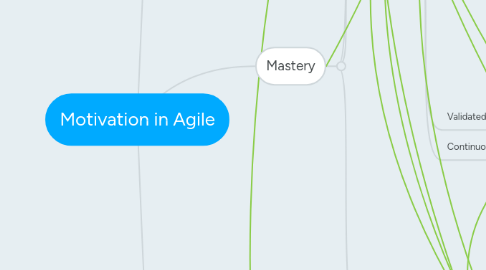
1. Autonomy
1.1. Team
1.1.1. Self-Organizing
1.1.1.1. Sprint Backlog
1.1.1.1.1. Protected & Time-Boxed Sprint
1.1.1.1.2. The "How"
1.1.1.2. Team Culture
1.1.1.2.1. Go Beyond “Empowerment”
1.1.1.2.2. Environment of Mutual Influence
1.1.1.2.3. Self-Regulate: Remove Bad Apples
1.1.1.3. Retrospectives
1.1.2. Cross-Functional
1.1.2.1. No More Heros
1.1.2.2. No Sub-Teams
1.2. Servant Leadership
1.2.1. Leadership By Intent
1.2.2. Leader-Leader v. Leader-Follower
1.2.3. Leading Through Respect, Empathy & Humility
1.3. Agile Manifesto
1.3.1. Individuals & Interactions over Processes & Tools
1.3.2. Responding to Change over Following a Plan
1.3.3. Agile Principles
1.3.3.1. Build projects around motivated individuals. Give them the environment and support they need, and trust them to get the job done.
1.3.3.1.1. Levels of Consciousness
1.3.3.1.2. Integral Windows (I, It, Its, We)
1.3.3.1.3. Mindfulness, Flow & Hyperproductivity
1.4. Culture follows Structure
1.4.1. Agile Personnel Management
1.4.1.1. No Annual Reviews
1.4.1.2. No Managers @ Team Level
1.4.1.3. Team Incentives v. Individual Incentives
1.4.2. Agile Budgeting
1.4.2.1. Budget Long Standing Teams Not Projects
1.4.2.2. Authorize Funding for Initiatives
1.4.2.3. Quarterly Funding Review v. Annual Budgeting
1.4.3. Eliminate policies, procedures, Management by Objectives (MBOs) that cause the wrong behaviors and de-motivate people.
1.4.4. Agile Metrics
1.5. Direction in Agile
1.5.1. Regulatory Compliance
1.5.2. Technical Standards
1.5.3. Non-Functional Requirements
1.5.4. Synchronization & Alignment
1.5.4.1. Product Roadmap
1.5.4.2. Architectural Roadmap
1.5.4.3. Release Plan
1.5.4.4. Sprint Cycle
1.6. Decouple Dependencies
2. Mastery
2.1. Specialization
2.1.1. Generalizing Specialist
2.1.2. Specialized Generalist
2.2. Training
2.2.1. Mentorship
2.2.1.1. Pair Programming
2.2.2. Workshops
2.2.3. Structured Courses
2.2.4. Certification Courses
2.2.5. Community of Practice
2.2.6. Coaching
2.2.6.1. Agile Manifesto
2.2.6.1.1. Agile Principles
2.2.6.2. Practitioner
2.2.6.2.1. Scale
2.2.6.3. Transformer
2.2.6.3.1. Shu-Ha-Ri
2.2.6.3.2. Forming-Storming-Norming-Performing
2.2.6.3.3. Train for critical thinking, not compliance
2.2.6.3.4. Habits, Checklists, Recipes, Intuition
2.2.7. Validated Learning
2.2.8. Continuous Learning
2.3. Agile Principles
2.3.1. Continuous attention to technical excellence and good design enhances agility.
2.3.1.1. eXtreme Programming (XP)
2.3.1.1.1. Continuous Refactoring
2.3.1.1.2. Pair Programming
2.3.1.1.3. Emergent Design
2.3.1.1.4. Test Driven Development (TDD)
2.3.1.1.5. Continuous Integration (CI)
2.3.1.2. Self-Discipline
2.3.1.3. Lean Thinking
2.3.1.4. Test First Mentality
2.3.1.4.1. Design For Testability (DFT)
2.3.1.5. Continuous Deployment
3. Purpose
3.1. Vision (Shared Understanding)
3.1.1. The "Why"
3.1.1.1. Sprint Goal
3.1.1.1.1. Swarming
3.1.1.1.2. WIP Limits
3.1.1.2. System Optimization Goal
3.1.1.2.1. Decrease Cycle Time (Concept to Cash)
3.1.1.2.2. Increase Business Value (ROI $)
3.1.1.2.3. Increase Agility (Flexibility)
3.1.1.2.4. Decrease Waste (Efficiency)
3.1.1.3. Context
3.1.2. The "Who"
3.1.2.1. Persona Development
3.1.3. The "What"
3.1.3.1. Product Backlog
3.1.3.1.1. User Stories
3.1.3.1.2. Prioritization
3.1.3.2. Program Backlog
3.1.3.3. Portfolio Backlog
3.1.4. Definition of Ready (DoR)
3.1.4.1. INVEST
3.1.5. Definition of Done (DoD)
3.1.6. Change from “avoiding mistakes” to “operational excellence”
3.1.7. Transformation
3.1.7.1. Reasons for transformation to agile-lean
3.1.7.1.1. Company's reasons
3.1.7.1.2. Team's reasons
3.1.7.1.3. Individual's reasons
3.1.7.2. Transformation Plan
3.1.7.2.1. Start State
3.1.7.2.2. End State
3.2. Agile Manifesto
3.2.1. Working Software over Comprehensive Documentation
3.2.2. Customer Collaboration over Contract Negotiation
3.2.3. Agile Principles
3.2.3.1. Customer Satisfaction
3.2.3.2. Devs & Business work together
3.2.3.3. Working software is the primary measure of progress.
3.2.3.3.1. Release Early & Often
3.2.3.4. Sustainability
3.2.3.5. Simplicity--the art of maximizing the amount of work not done--is essential.
3.2.3.5.1. Minimal Marketable Feature (MMF)
3.2.3.5.2. Minimal Viable Product (MVP)
3.2.3.5.3. Pareto Rule (80/20)
3.2.3.5.4. Minimal Business Increments (MBI)
3.2.3.6. The best architectures, requirements, and designs emerge from self-organizing teams.
3.3. Belonging
3.3.1. Organizational clarity means that everyone knows their role
3.3.2. Group Celebration
